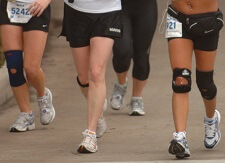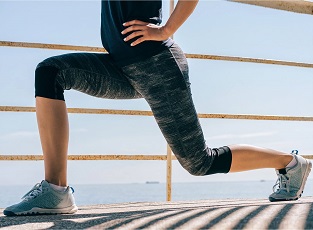- Home
- Knee Surgery
- ACL Surgery
- Recovery
Recovery After ACL Surgery
Written By: Chloe Wilson, BSc(Hons) Physiotherapy
Reviewed by: KPE Medical Review Board
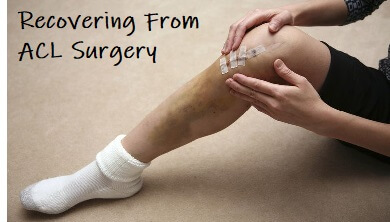
Recovery after ACL surgery is a slow process, taking on average 9-12 months.
The outcome is usually extremely positive, ACL reconstruction surgery having a success rate of approximately 90%. However, problems can occur both in the short term and long term.
The chances of developing problems after ACL knee surgery are greatly reduced by following a strict rehab programme and having realistic expectations about the ACL recovery process.
Problems after ACL surgery are usually minor and short lived, but some people do experience ongoing problems. Here we will look at the most common problems that occur and how to avoid and treat them.
What Happens During ACL Surgery?
ACL reconstruction knee surgery involves replacing the torn anterior cruciate ligament with a new graft. This is taken either from your own tissue (autograft), or from donor tissue (allograft).
If using an autograft, the surgeon harvests some tissue from either your patellar tendon (below your kneecap) or you hamstrings tendon (on the back of your thigh). They use these to create a new graft which is fixed into place and to do the job of the ACL.
You can find out loads more about what happens during surgery in the ACL recontruction surgery section.
Risks Of ACL Surgery
Any knee surgery carries risks, but the risks from ACL surgery are generally small:
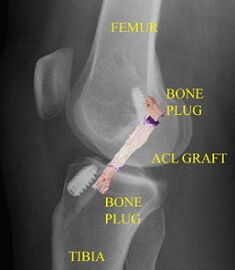
- Infection: there is a very small risk of developing an infection after ACL knee surgery in the incision. If this happens, you will be given antibiotics
- Deep Vein Thrombosis: A blood clot and/or infection can occur as in all operations. This risk is 1-2%. You may be given pressure stockings to wear for a few days after surgery or blood thinning medication
- Anaesthesia Complications: anaesthesia does carry risks, but serious risks such as cardiac arrest or paralysis are extremely rare. Some people suffer from symptoms such as nausea, vomiting and headaches after ACL surgery but these usually settle quickly
“Normal” Short Term Problems
People usually recover really well after ACL surgery, but many report a few problems in the early stages. These are completely normal and usually nothing to worry about.
Common problems after ACL surgery include:
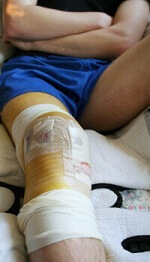
- Swelling: Swelling can last up to 3 months after ACL surgery. This can be eased by using RICE therapy, a combination of appropriate rest, ice therapy, elevation and tubigrip compression bandage – visit the RICE section to find out more.
- Difficulty Kneeling: Kneeling often causes pain after surgery initially, but with gradual progression through use of a cushion, then carpet, then hard floor, this usually improves.
- Bruising: Bruising often appears down to the heel (usually on the inner side) and can last 4-6 weeks. It can make the lower leg very tender. Keeping the leg elevated can help with this.
- Numbness: Numbness around the scars is common due to damage to the small nerves around the knee from the incisions. It usually settles down after a few months, but occasionally it can persist long term. Numbness does not usually cause any functional problems.
- Knee Pain: Some pain after ACL surgery is common both at the knee itself and around the new graft area but it is usually quite tolerable. It is important to be taking regular, adequate pain relief as advised by your doctor to keep this under control so you can follow your rehab programme
Potential Long Term Problems
Whilst the outcome of ACL reconstruction surgery is usually extremely positive, occasionally longer term problems do occur.
Potential longer term problems after ACL knee surgery are:
- Lack of Stability: Sometimes the new ACL graft
does not provide enough stability to allow return to full sporting
activities. This is usually due to either the ligament not healing in a
tight enough position or from associated damage inside the knee.
Tailored rehab programmes and wearing an ACL brace can help with this.
- Patella Pain: Anterior knee pain with activities such as squatting and sitting can develop in 10-20% of patients after ACL surgery. It is less common if people fully comply with their rehab programme following surgery.
- Patellar Tendonitis: Inflammation of the patellar tendon, aka patellar tendonitis after ACL surgery can occur with a patellar tendon graft due to having the middle third portion of the tendon removed to make the new graft. Following your rehab programme is the best cure.
- Knee Stiffness & Weakness: Stiffness is a common problem after ACL surgery, particularly extension (straightening the leg) but the chances of developing this are greatly reduced by starting exercises as soon as possible and strictly complying with the post-op rehab programme. It is important when resting with your leg elevated not to have anything underneath your knee as you want to be stretching it out.
- Re-Rupture: Although extremely rare, the ACL graft can re-rupture in 1-2% of cases. It is more common when allograft tissue from a donor is used rather than autograft tissue (from yourself). The new ligament is most vulnerable 6-12 weeks after surgery. Wearing an ACL brace for the first few weeks after surgery may be advised to minimise the risk.
- Knee Arthritis: Recent studies are suggesting an increased risk of developing arthritis later in life after ACL surgery. ACL injuries rarely occur in isolation, they are often accompanied by damage to the cartilage and other parts of the knee.
However, it is important to remember that there is also an increased risk of developing arthritis after an ACL injury if you haven’t had surgery too. The most important factor in reducing the risk of developing arthritis is to regain full stability and strength at the knee, whether or not you have surgery.
Minimising Problems after ACL Surgery
As you can see, these problems often stem from problems with the rehab programme, either from a poorly designed programme or poor patient compliance. It is really important to follow the advice of your surgeon and physio and to rigidly stick to your rehab and recovery programme.
Recovery after ACL surgery is a slow process and it takes at least 6 months before you can start thinking about returning to sport. You can find out more about the recovery and rehab process after ACL surgery including a recovery timeline in the ACL recovery and rehab protocol sections.
What Else Can Help?
Understanding what ACL injuries, what surgery involves and the full rehab process can make a huge difference with ACL knee injuries. Check out these articles which explain everything you need to before and after ACL surgery.
- ACL Injury Overview: Causes, symptoms and diagnosis
- ACL Surgery: Do you need surgery and what does it involve
- ACL Reconstruction: What happens before, during and after surgery
- ACL Surgery Problems: Potential problems encountered after surgery
- Recovering From Surgery: Recovery time guide following surgery
- ACL Rehab Protocol: Rehab exercises & activities after surgery
- Injury Prevention: How to avoid an ACL knee injury
Page Last Updated: 10/15/21
Next Review Due: 10/15/23
